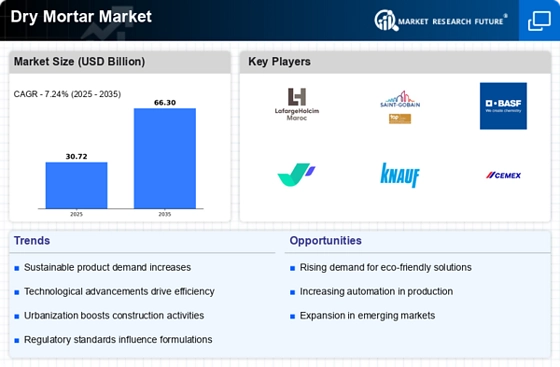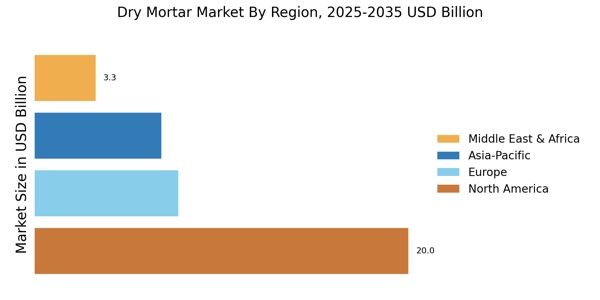Urbanization Trends
Rapid urbanization is reshaping the landscape of construction, thereby driving the Dry Mortar Market. As populations migrate towards urban centers, the demand for residential and commercial buildings is surging. This trend necessitates efficient construction materials that can expedite building processes while ensuring structural integrity. Dry mortar products, known for their ease of use and quick application, are becoming increasingly popular among contractors. According to recent estimates, urban areas are expected to house nearly 68% of the world population by 2050, which could lead to a significant increase in construction activities. Consequently, the Dry Mortar Market is poised to benefit from this urban expansion, as builders seek reliable and effective solutions to meet the growing demand.
Sustainability Initiatives
The increasing emphasis on sustainability within the construction sector appears to be a pivotal driver for the Dry Mortar Market. As environmental regulations tighten, construction companies are increasingly adopting eco-friendly materials and practices. This shift is likely to enhance the demand for dry mortar products that are formulated with sustainable ingredients. For instance, the use of recycled materials in dry mortar formulations not only reduces waste but also aligns with the growing consumer preference for green building solutions. The market for sustainable construction materials is projected to grow at a compound annual growth rate of approximately 10% over the next few years, indicating a robust opportunity for the Dry Mortar Market to innovate and expand its product offerings.
Technological Advancements
Technological innovations are playing a crucial role in shaping the Dry Mortar Market. The advent of advanced mixing technologies and automated application systems is enhancing the efficiency and quality of dry mortar products. These innovations not only reduce labor costs but also improve the consistency and performance of the final product. For example, the integration of smart technologies in construction processes allows for real-time monitoring and adjustments, ensuring optimal results. The market for construction technology is expected to witness substantial growth, with projections indicating a rise of over 15% annually. This trend suggests that the Dry Mortar Market must adapt to these technological advancements to remain competitive and meet the evolving needs of the construction sector.
Rising Construction Activities
The resurgence of construction activities across various sectors is a significant driver for the Dry Mortar Market. With governments investing heavily in infrastructure development, there is a marked increase in the construction of roads, bridges, and buildings. This uptick in construction projects is likely to elevate the demand for dry mortar products, which are essential for various applications such as masonry, plastering, and flooring. Recent data indicates that the construction industry is projected to grow at a rate of 5% annually, driven by both public and private sector investments. As a result, the Dry Mortar Market stands to gain from this growth, as contractors seek reliable materials to meet project timelines and quality standards.
Increased Demand for Prefabricated Construction
The growing trend towards prefabricated construction methods is influencing the Dry Mortar Market. Prefabrication allows for faster construction timelines and reduced labor costs, making it an attractive option for builders. Dry mortar products are particularly well-suited for prefabricated elements, as they facilitate quick assembly and ensure strong bonding between components. The prefabricated construction market is anticipated to expand significantly, with estimates suggesting a growth rate of around 8% per year. This trend indicates a potential increase in the demand for dry mortar solutions tailored for prefabrication, thereby providing opportunities for manufacturers within the Dry Mortar Market to innovate and cater to this evolving segment.


















Leave a Comment